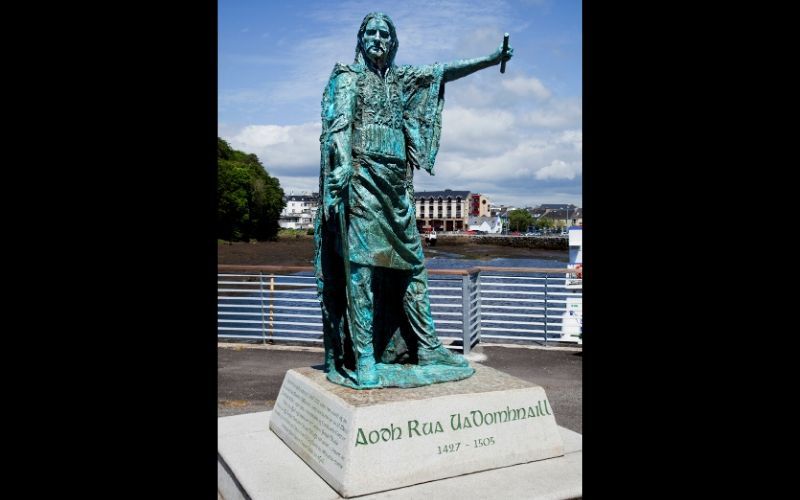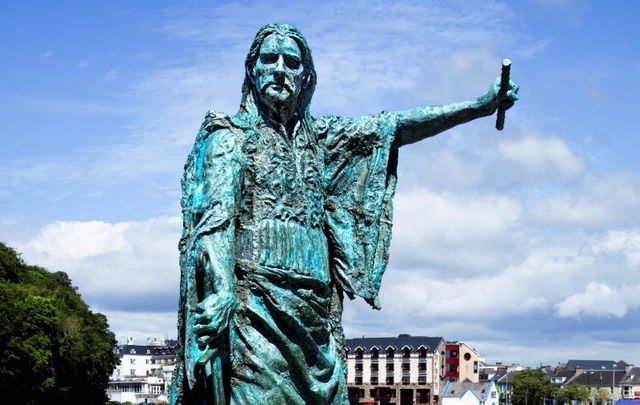Red Hugh O’Donnell died and was buried in Valladolid, Spain in 1602.
Archaeologists said they believe they are “close” to finding the remains of Irish chieftain Red Hugh O’Donnell as they excavate the area in Valladolid, Spain, where the historic Irish figure is believed to have been buried.
Read More: Dublin Viking dig uncovers Ireland’s first prison cells
On May 22, reports from the excavation site revealed that bones - a skull and a femur - had been uncovered. Archaeologists believe that O’Donnell’s remains will be relatively easy to identify as he was missing toes following a case of frostbite that he incurred while hiding in the Wicklow mountains after escaping from Dublin Castle where he was imprisoned.
Donegal News reports that Donegal man Brendan Rohan, who visited Valladolid last year to search for O'Donnell's burial site, was key to launching the excavation that began earlier this week.
Of his visit last year, Rohan told the publication: “Of course it was a fruitless search, and I was passed from ‘billy to jack’ and searched many ‘blind alleys’ for three days until I met the Director of Cultural Tourism who had a ‘gra’ for Ireland and I enthused him with the idea.
“He passed me to the Director of Archives who more or less told me I was wasting my time because in the secularisation of Spain in the 1800s, that whole property was sold and levelled and the gravesite lost.
“However, the day after I left, some other officials began contacting me, and bit by bit, an idea was born, and eventually a full-blown archaeological dig was authorised, which began on Monday morning and I am delighted.”
Valladolid’s city council said in a statement this week that it had begun an excavation effort to locate the 'Maravillas' chapel of the disappeared convent of San Francisco where Red Hugh O’Donnell is believed to have been buried. The site is also where Christopher Columbus is believed to have been buried about a century prior.
The city council said the discovery of the remains of the two historic figures “would be an important finding from a historical perspective, but also for the dissemination of the city in Spain and abroad.”
The operation is being led by investigators Óscar Burón and Juan Carlos Urueña who are working in conjunction with archaeologists Olatz Villanueva (also a member of the Simancas University Institute of History) and Jesús Misiego.

The statue of Red Hugh O'Donnell in Co Donegal (Getty Images)
Read More: Archaeologists find Neolithic quay near Newgrange
Red Hugh O’Donnell, who chief archaeologist Óscar Burón this week described as an “Irish prince and the hero of the resistance against the English,” ruled over parts of the north of Ireland alongside his father-in-law Hugh Mor O’Neill in the 16th century.
In 1593, the noble duo mounted an effort against English rule in Ireland, now known as the Nine Years War. While the Irish maintained some degree of success earlier in the war, the Battle of Kinsale in 1602 proved to be disastrous, and Red Hugh O’Donnell afterward fled to Spain to seek support from King Felipe III.
As Valladolid’s city council puts it, “The open enmity between England and a Spain that still remembered the affront of the Invincible Army made the Spanish king a natural ally of the Irish.”
When traveling to meet with King Felipe III, O’Donnell died in Simancas on September 10, 1602; he was either poisoned by James “Spanish” Blake, an Irish traitor, or died due to an infection from a tapeworm. He was 29 years old.
King Felipe III prepared the Irish man's funeral with royal honors in the convent of San Francisco. According to the Annals of the Four Masters, O’Connell’s body "was conveyed to the king’s palace at Valladolid in a four-wheeled hearse, surrounded by countless numbers of the king’s state officers, council, and guards, with luminous torches and bright flambeaux of beautiful wax-light burning on each side of him.”
O'Donnell is remembered today as a hero in Spain and in 2011, a plaque was unveiled in the Callejón de San Francisco in Valladolid, in memory of his burial in the old convent of the same name.
Read More: The truth about Brian Boru, the legendary High King of Ireland
On Twitter, the Culture and Tourism Office of Valladolid has been charting the daily progress of the excavation. (Translations of each tweet are provided by Google Translate.)
Day 1:
En busca de Red Hugh O'Donnell, el William Wallace irlandés que terminó sus días en Valladolid y recibió sepultura en el desaparecido convento de San Francisco #odonellVLL (abrimos hilo) pic.twitter.com/Q0MW90tNns
— Cultura Turismo VLL (@infoVLL) May 20, 2020
Google Translation: "In search of Red Hugh O'Donnell, the Irish William Wallace who ended his days in Valladolid and was buried in the disappeared convent of San Francisco #odonellVLL (we open thread)"
Día 1. #ExcavaciónArqueológicaVLL
— Cultura Turismo VLL (@infoVLL) May 20, 2020
Asisten los Investigadores del proyecto: Oscar Burón y Juan Carlos Urueña. Así como los Arqueólogos: Olatz Villanueva y Jesús Misiego.
Se levanta el suelo y se llega hasta dos metros de profundidad pic.twitter.com/vvrVS0fTlg
Google Translation: "Day 1. #ExcavaciónArqueológicaVLL The researchers of the project attend: Oscar Burón and Juan Carlos Urueña. As well as the Archaeologists: Olatz Villanueva and Jesús Misiego. The ground is raised and it reaches a depth of two meters."
Day 2:
Día 2. #ExcavaciónArqueológicaVLL
— Cultura Turismo VLL (@infoVLL) May 20, 2020
La excavación se acerca hacia la zona donde se supone estaría la capilla. Comienzan a aparecer restos humanos pero se supone que son anteriores a 1836 (destrucción del Monasterio) y sin relevancia para la investigación pic.twitter.com/lNM33tfNHL
Google Translation: "Day 2. #ExcavaciónArqueológicaVLL The excavation is approaching the area where the chapel is supposed to be. Human remains begin to appear but it is assumed that they are prior to 1836 (destruction of the Monastery) and of no relevance to the investigation."
Day 3:
Día 3. #ExcavaciónArqueológicaVLL
— Cultura Turismo VLL (@infoVLL) May 20, 2020
Noticias esperanzadoras ??
Aparece un muro en perfectas condiciones, de una anchura de 127 cm, y que va en dirección hacia donde supuestamente se encuentra Capilla de las Maravillas, y donde se enterró a Red Hugh O'Donnell #odonnellVLL pic.twitter.com/c41Py8bP88
Google Translation: "Day 3. #ExcavaciónArqueológicaVLL Hopeful news. A wall appears in perfect condition, a width of 127 cm, and goes in the direction of where the Chapel of Wonders is supposedly located, and where Red Hugh O'Donnell was buried. #odonnellVLL"
Day 4:
Día 4 #ExcavaciónArqueológicaVLL
— Cultura Turismo VLL (@infoVLL) May 21, 2020
Parece que vamos por buen camino. Aparece un 2º muro, más estrecho que el encontrado el tercer día.
Pendiente de catalogar por los arqueólogos, podría ser un muro interior de la Capilla de las Maravillas
Red Hugh O'Donnell más cerca #odonnellVLL pic.twitter.com/YUGkiRNUci
Google Translation: "Day 4 #ExcavaciónArqueológicaVLL It seems that we are on the right track. A 2nd wall appears, narrower than the one found on the third day. Pending to be cataloged by archaeologists, it could be an interior wall of the Chapel of Wonders. Red Hugh O'Donnell closer #odonnellVLL."
Day 5:
Día 5. #ExcavaciónArqueológicaVLL
Hoy nos ha visitado la concejala de Cultura de @AyuntamientoVLL Ana Redondo
Aparece una parte de cráneo, un fémur, y algunos restos más en lo que parece ser el acceso a la Capilla de Las Maravillas.
Estamos cerca ☘️
#odonellVLL pic.twitter.com/gWflSgJkgr
Google Translation: "Day 5. #ExcavaciónArqueológicaVLL Today the Councilor for Culture of @AyuntamientoVLL Ana Redondo - A part of the skull, a femur, and some more remains appear in what appears to be the access to the Chapel of Las Maravillas. We are close. #odonellVLL"
El investigador Óscar Burón nos habla de la Capilla de las Maravillas, sala del Monasterio de S. Francisco que se busca estos días en el subsuelo de la calle Constitución ⚒️ y que, según la investigación, alberga los restos de Colón y de Red Hugh O'Donnell #ODonnellVLL pic.twitter.com/H9SCZpdO1I
— Cultura Turismo VLL (@infoVLL) May 22, 2020
Google Translation: "The researcher Óscar Burón tells us about the Chapel of Wonders, a room in the Monastery of S. Francisco that is being sought these days in the basement of Calle Constitución and that, according to the investigation, it houses the remains of Columbus and Red Hugh O'Donnell #ODonnellVLL."
Read More: Three million people in the world are descended from one Irish High King




Comments